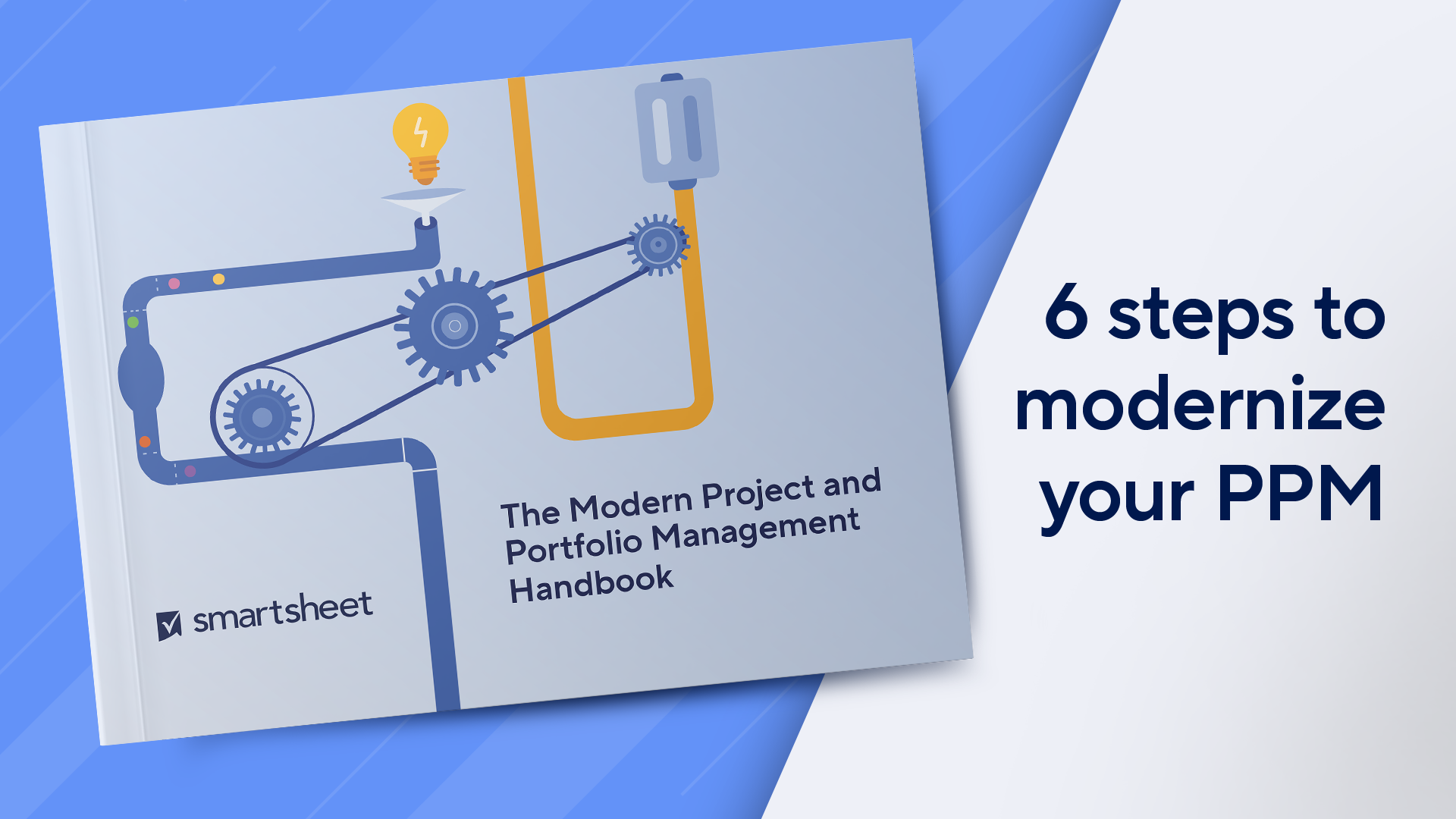What Is Enterprise Project Portfolio Management?
Enterprise project portfolio management (EPPM) is the practice of taking a high-level business strategy and breaking it into smaller initiatives in order to understand the work that needs to be done at a more tactical level.
Effective EPPM increases alignment between an organization’s projects, programs, portfolios, and the overall business strategy. Organizations that successfully implement EPPM are in sync at the corporate strategy level and produce more successful project outcomes in the long run.
EPPM is often run by an enterprise portfolio management office (EPMO), which helps to both establish and oversee the governance of these specific programs and projects. An EPMO integrates and scales the priorities that corporate-level strategists created to ensure that teams allocate resources effectively and hit their goals.
What Does Enterprise Project Portfolio Management Do for an Organization?
EPPM provides organizations with visibility into active work. This insight ensures that all ongoing work is linked to an organization’s strategies and objectives.
In addition, EPPM enables organizations to better manage execution of projects and programs and surface key insights, such as whether a project is impacting a strategic objective, what business units are working on the same or similar projects, the resources allocated for each project, and projected project and program costs.
With EPPM, each part of an organization can align itself with larger business objectives and work together to avoid redundancies and maximize ROI.
To achieve effective EPPM, companies need to leverage the EPMO, which should ideally address the following items:
- Projects to be funded
- Projects to be cancelled or postponed
- Underperforming projects or projects that need outside intervention
- Insight into how to improve project risk, as well as compliance management and monitoring
- Attraction, retention, and motivation of all employees and team members
- Product and project costs, as well as the ways in which they can improve or harm profit margins
- The most mission-critical projects for the upcoming quarter and year
The Modern Project and Portfolio Management Handbook
A modern approach to project and portfolio management can help equip you and your teams to tackle projects and programs at scale.

This handbook will help you:
Identify pain points in your current processes
Learn from examples of businesses using modern PPM strategies
Implement your own updated PPM strategy
Why Companies Need an Enterprise Portfolio Management Office
Companies need an enterprise portfolio management office (EPMO) to evaluate and prioritize projects against the greater business objectives and goals. This analysis helps them to better allocate resources and budget.
Jason Kinder is the Director of Marketing at Pinnacle Management Systems. “Organizations must be able to adapt and move quickly, which necessitates the need to pull traditionally disconnected systems into one enterprise-level view,” he says.
The Role of the Enterprise Portfolio Management Office
An enterprise portfolio management office also helps to solve the following problems:
- Redundancies across teams
- Lack of visibility into the work getting done, and how it tracks against the greater strategic objectives
- Project delays and missed deadlines
- Resourcing bottlenecks
- Unnecessary spending and missed ROI
How Is Enterprise PPM Different from Traditional PPM?
Whereas traditional project portfolio management focuses on delivering projects at the business unit level, enterprise PPM covers all the projects, programs, and portfolios that align with the organization’s strategic objectives.
According to Keith Gillette, Founder and CEO of TaskTrain, “In general, EPPM integrates PPM into the entire operating context of the organization as an integrated business management solution … enterprise project, program, and portfolio management integrate those project-oriented practices and systems into the ongoing production and supporting business processes of the organization in alignment with strategic objectives to create a single enterprise management system.”
Margaret Meloni, President of Meloni Coaching Solutions, Inc., says, “When I think of EPPM, I think of the best, most efficient, and successful PMO on steroids, in a good way. Being on steroids means that it is big and strong and able to lift the enterprise to success through successful project execution.”
Objectives of Enterprise Project Portfolio Management
The main objective of EPPM is to provide a high-level, 360-degree view of all projects, programs, portfolios, and collective efforts of an organization. This overview is critical to running a business smoothly and adapting to change effectively.
According to research from CB Insights, 60 percent of companies take more than a year to bring a new product to market. This, in itself, is a reason why organizations rely heavily on PPM to bring together all components of their programs and ensure that plans run smoothly, efficiently, and quickly.
EPPM should also bring together all the components of a project or program, such as financial accounting, supply chain management, and CRM.
Advantages of Enterprise Project Portfolio Management
EPPM offers many advantages, including greater alignment between a one-off project and larger business objectives, fewer redundancies, and less interruption in work.
Other advantages include the following:
- Better resource and budget allocation
- Improved predictability with regard to project frameworks and approaches
- Fewer reactionary decisions
- Better project prioritization
- Improved project ROI tracking
Gillette reiterates these advantages. “EPPM promises enterprises the ability to achieve operational excellence while adapting to rapidly changing market circumstances,” he says.
Kinder makes similar points about EPPM: “Management by exception is something that I have always advocated. An EPPM system points to issues that require immediate attention and prevents those issues from getting lost in the shuffle.”
How to Build an Enterprise Project Portfolio Management Process
Building an effective enterprise project portfolio management process can be easy and seamless, if you follow a template. To create your own process, follow the steps below.
- Create a Project Inventory: Start by identifying all projects, programs, and portfolios throughout the organization, including key information and project details. Then organize the projects by priority and alignment with the organization’s strategic objectives. This is where a PMO can play a valuable role in helping you decipher which projects can proceed.
- Discuss Critical Questions: As you create your project inventory, think through the following questions:
- What are the most mission-critical projects to complete over the course of the next year?
- Which projects should we fund?
- Which projects involve the highest risk, and how can we mitigate these risks?
- Which existing projects are underperforming?
- How can we improve project monitoring with regard to risk and compliance?
- How can we effectively attract, maintain, and motivate our employees to perform?
- How can we better manage project costs and improve margins?
- Develop Your EPMO: As you work through the projects and programs and their relevant priorities, start to incorporate your EPMO and position it correctly within the organization (typically, this occurs wherever strategic planning happens).
- Align Your Projects: Now that you have an idea of the projects you want to advance, align them with the organization’s overall strategy and objectives so that you can evaluate how to budget and plan for them.
- Appoint an Implementation Team: This team should be made up of key stakeholders, portfolio, program and project managers, and the team members who will facilitate the new systems involved in your EPPM.
- Launch Your EPPM: Implement your newly developed EPPM using a central EPM platform, which should track the progress of all projects in flight, the success metrics of each project, internal and external project resources, strategic objectives, and other key details.
- Monitor Execution and Compliance: Your EPPM system should monitor project status and progress on a regular basis so that you can continually keep stakeholders informed. Additionally, your system should ensure proper project governance for accountability and alignment between project teams and the greater organization.
- Garner Actionable Business Insights: Your EPPM system should be able to surface role-based insights, so you always have information regarding the responsibilities of each role and how team members are tracking against overall project progress.
As Kinder says, “Different roles require different data. Ensure that dashboards are role specific and provide the right data for the user to make informed decisions.” - Set Up Patterns of Traceability: To make your EPPM as effective as possible, you’ll need to be able to track the who, what, and when for each project and program, and to make sure that all actions maintain alignment with the main objectives. Doing so ensures that each role has access to the right information and doesn’t need to waste time searching for the correct data to make business decisions.
- Create a Document for Lessons Learned: This document should include lessons learned from each project and serve as a post-mortem. This way, you can repeat actions that went well and do away with any details that bogged down a project. This document should be easy to access for all parts of your organization.
Enterprise Project Portfolio Lifecycle
Three main components comprise the enterprise project portfolio lifecycle: start-up decision making, investment and budget maintenance, and exit strategy planning.
- Start-Up Decision Making: Also known as greenlighting or gaining stakeholder buy-in and business approval, this part of the lifecycle addresses the success metrics that will be used to track and rate each project. Document any changes made to these initial decisions in a change record or change log.
- Investment and Budget Maintenance: Once your EPPM is underway, you should constantly monitor the planned versus actual expenses, so you have an accurate picture of the budget. Doing so will also help you and other key stakeholders determine whether or not to halt projects or rethink a business strategy.
- Exit Strategy Planning: Also called sunsetting or retirement planning, this part of the lifecycle should help you create an exit strategy for a project or program if the need arises.
Tips for Implementing EPPM
Some of the most helpful tips from enterprise PPM experts include prioritizing project risks and identifying remedies. If possible, you should cancel projects that no longer align with the organization’s strategies and avoid micromanagement.
More enterprise project portfolio management tips include the following:
- Give team members the autonomy and flexibility to complete their work based on the EPPM by simplifying time and task management.
- Prioritize data capture in real time so that you can make faster business decisions and better comply with project requirements and deadlines.
- Use automated EPPM tools and software to simplify your processes and keep everyone in the loop with real-time reporting.
- Gain buy-in from stakeholders as soon as possible.
“EPPM is an enterprise-level toolset of use to top executives in strategic decision making,” says Gillete. “Therefore, it’s critical that the implementation has the buy-in of the top executives.”
Meloni expresses a very similar sentiment about buy-in and implementation: “Implementation really begins in the hearts and minds of your people. There is no place for negative politics and power grabs. There must be a spirit of collaboration and trust. Everyone must understand that career advancement comes through supporting the system, not circumventing it.”
To get started with your EPPM using helpful PPM-related templates, visit this article with a wide variety of free, downloadable templates.
Enterprise Project Portfolio Metrics
The success of an EPPM can be measured by a variety of metrics, including financial (e.g., ROI), as well as more qualitative data, such as employee satisfaction.
You can also include balanced scorecard criteria to identify and measure the strategy and success of your EPPM. Additionally, you can measure specific success by breaking down the metrics by role. For example, a project manager might rank success based on cost and days to complete a project, whereas an accounting executive might measure success based on amounts payable, amounts receivable, and numbers of invoices.
As Gillette says, “The best measures for the success of EPPM implementation are those the enterprise already uses to judge itself: Have the key performance indicators from a company’s existing performance measurement system improved a year after implementation? Have profit, revenue, or market share increased to represent a return on investment for costs of the EPPM implementation?”
Kinder, on the other hand, states that user adoption is his main metric of focus. “The EPPM system is successful if I exceed our goal of number of users. That tells me that the system is beneficial and gives them the right data to make educated decisions.”
Meloni has similar thoughts. “While there are some scope, schedule, budget, quality, and change metrics that are widely used, the right metrics are the metrics that support the reason for your implementation of EPPM. This is about measuring what matters to your organization,” she says.
Challenges of Enterprise Project Portfolio Management
The main challenges of enterprise PPM include complex governance over single projects and programs, as well as developing a strategic, well-thought-out, and well-documented plan of execution.
Other challenges of enterprise PPM include the following:
- Stringent Financial Management: There is no room for error when it comes to authorizing, recording, and reporting on the finances associated with your projects and programs. To boost ROI and remove inefficiencies, an organization must be dedicated to stringent financial controls and compliance.
- Lack of Specific Management Skills: When implementing an EPPM, you must artfully consider the skills of the project team and implement training, if needed.
- Choice of EPPM Tools: As Kinder says, “Spend the necessary time up-front defining requirements and evaluating tools. I’ve seen it over and over again where the decision to purchase a tool was made without a thorough evaluation, and within a year or two, they are looking for a replacement.”
- KPI Overload: Ensure that you don’t have too many KPIs to monitor and execute. Kinder recommends “four to six KPIs on a dashboard and then you can begin to dig into the root of the issue. Do not overwhelm people with dozens of KPIs because not every metric is key.”
Streamline Enterprise Project Portfolio Management with Smartsheet
From simple task management and project planning to complex resource and portfolio management, Smartsheet helps you improve collaboration and increase work velocity -- empowering you to get more done. The Smartsheet platform makes it easy to plan, capture, manage, and report on work from anywhere, helping your team be more effective and get more done. Report on key metrics and get real-time visibility into work as it happens with roll-up reports, dashboards, and automated workflows built to keep your team connected and informed. When teams have clarity into the work getting done, there’s no telling how much more they can accomplish in the same amount of time. Try Smartsheet for free, today.



